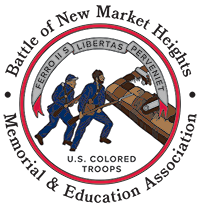One of the things that I’m sure nags many Civil War authors is the regret that they feel over not being able to include every detail and account that they unearth during their research for their books. For me, one of the great heroes of New Market Heights who I wish I could’ve spent more time on was 1st Sergeant Milton M. Holland of the 5th USCI. Holland was one of the 14 black Medal of Honor recipients from that historic clash of arms, and his life story is one that I found to be particularly fascinating.
Milton Holland was born in Texas, fathered by Bird Holland, a white slave owner who would later fight for the Confederacy. Milton’s mother was a slave on the plantation owned by Bird’s brother. Milton was one of three brothers that were born from this relationship. When he and his brothers were young, his father purchased their freedom from his brother, their uncle and slave master, and sent the three boys to a school in Ohio. Holland was still residing in Ohio when Civil War broke out in 1861.
In what will be the first installment of two posts on Holland’s remarkable life, I will now let the good sergeant give you his story in his own words. The following comes from a letter that Holland wrote to Lt. Col. Joseph P. Mitchell, who was then compiling information on Civil War Medal of Honor recipients. It is interesting to note that Holland chose to write the letter in the third person.
Milton M. Holland was born in the state of Texas in 1844. He was attending school in Athens County, Ohio, in 1861 when the first call was made for volunteer soldiers, and responded to the call of his country. He enlisted in the Union Army in April, 1861, but was rejected on account of his youth. But so determined was he to serve his country that he immediately sought employment in the Quartermaster Department and served under Colonel Nelson H. Van Hores of the 3rd, 18th, and 92nd Ohio Volunteer Infantry.
He served in this capacity until he was regularly mustered into the Union Army in June 1863 and assigned to the 5th United States Colored Troops, a regiment raised in Ohio and accredited to that state. Within his regiment he engaged in the campaigns in Virginia and North Carolina under the command of General B.F. Butler. In the winter of 1863 he was with his regiment in the raid through the Dismal Swamp into North Carolina, capturing forage and emancipating slaves under the then recent Emancipation Proclamation.
In the early winter and spring of 1864, he was with his regiment in the two raids from Yorktown, Virginia to Bottom’s Bridge just outside Richmond: the first raid being made for the purpose of liberating the Union prisoners confined at Libby Prison; and the second for the purpose of assisting General Kilpatrick who, in his attempt to relieve the Libby Prison men, had been surrounded by the Confederate forces.
He was with the James River fleet in its advance on Richmond and, as the fleet approached City Point, Company C, of which Holland was then the 1st Sergeant, was ordered to make the attack. The order was promptly obeyed and, without landing the vessel, the men jumped from the guard rail of the boat, wading water waist deep to reach the point of attack. They captured the Rebel flag, the signal; station and signal officers of the confederacy, thus stricking [sic] the first signal blow at the Rebel stronghold at Petersburg.
This regiment was part of the famous Black Brigade which General Smith at first refused to use in his charge on Petersburg on June 15, 1864. General Butler, commanding the corps, promptly ordered General Smith to march on Petersburg and storm her breastworks. General Smith led the black phalanx in the charge, and for the courage, the heroism, the daring and skill displayed by the colored troops in that bloody fight, General Smith remarked that he would lead men like those into any fight and rely upon their pluck.
His regiment was at the ‘Mine Explosion’ [The Battle of the Crater] on July 30, and was prepared to make the charge. They received instructions at a given signal to discharge their guns onto the enemy’s line, jump the parapet and the ditch, and make a charge to cover the ‘Crater’. But just before the signal was substituted in their place. This circumstance, young Holland has ever maintained, lost a key to the Union forces that otherwise would have been gained. It was at this battle that Holland had planned and decided to cover himself in glory. He was sorely disappointed but never relinquished the desire and intention to avail him of the first opportunity.
That opportunity would come at a place called New Market Heights…

1st Sgt. Milton M. Holland, wearing his Medal of Honor. Courtesy Rob Lyon.

